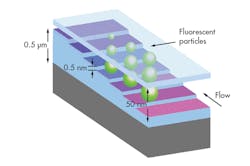Like nanometer-scaled sandblasting, focused beams of ions ablating hard materials could form intricate nano-sized three-dimensional patterns. But the beams could only create tiny features in the lateral dimensions—length and width. Engineers were stymied when it came to controlling the depth of this form of sandblasting.
Although engineers have for years used ion beams to fix defects in integrated circuits and machine tiny parts in optical and mechanical systems, those applications did not require the depth control the team has now reported. Researchers at the National Institute of Standards and Technology (NIST), however, recently discovered that fine-tuning a standard ion-beam technique would let it form structures with depths controlled to within the diameter of a single silicon atom.
Taking advantage of that newly demonstrated precision, the NIST team built a simple, nanofluidic device that takes precise measurement of nanoparticles in a liquid. The device has potential for mass production and could become a new laboratory standard for determining nanoparticle size. Such measurements could expedite quality control in industrial applications that use nanoparticles.
The team used the new technique with a gallium ion beam to machine a staircase in silicon dioxide and then enclosed it to contain the flow of fluid at the nanoscale. A lid limited the size of any nanoparticles that could make it to each step, with larger ones fitting on the “bottom” step, but only the smaller ones able to fit onto the “top” step (see illustration). The gallium beam let them control step size and they machined some devices with a step size of 1.1 nanometers; they machined others with a step size of 0.6 nanometers—just a few atoms in depth.
A nanofluidic staircase machined with subnanometer precision by a focused ion beam separates nanoparticles by size. (Courtesy of NIST)
Nanoparticles flowed in to the deepest step at the bottom of the staircase, but only the smaller ones could ascend toward the shallowest step at the top; larger nanoparticles could not fit through and remain trapped at the bottom set of steps. Fluorescent dye within the nanoparticles let the team record their locations with an optical microscope and match those locations with the known depth of the staircase.
Comparing nanoparticle sizes as determined by this ladder with sizes measured using electron microscopy revealed a match that was accurate to within one nanometer. This meant the nano-ladder could act as particle separator and be used a reference material for measuring nanoparticles.
Manufacturers who routinely perform quality control on nanoparticles—determining not only their average size, but how many of the nanoparticles are slightly smaller or larger than average from batch to batch—could benefit from the new technique. The team is now investigating how the devices could serve as master molds for the mass production of inexpensive replicas.
Because the nanoparticles are measured with an optical microscope, the NIST team could also explore the relationship between the size of nanoparticles and another key property: their brightness. Clarifying that relationship is important for understanding properties of nanoparticles such as quantum dots for color displays, gold nanoparticles for biomedical sensors, and other nanoparticles for drug delivery. Several customers of NIST’s nanotechnology user facility, the Center for Nanoscale Science and Technology—where the work was conducted—have expressed interest in adapting the technology for measuring both the size and brightness of nanoparticles in these consumer products.


